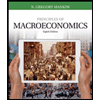
The impact of increasing real interest rate when others are kept constant.
Answer to Problem 1CQQ
Option 'c' is correct.
Explanation of Solution
The foreign exchange market is the place of market where the participants are able to buy and sell different foreign currencies with exchange to the domestic currency. Here, the lonable fund interest rate theory applies. The lonable fund includes all the forms of credit of the economy which includes the loans, bonds, and the savings deposits.
Option (c):
When the real interest rate in the economy increases while all other variables are kept constant in the economy, the incentive to save more will increase in the economy. This is because when the interest rates are higher, the interest earned from the savings will be higher. Since the investment and the rate of interest are inversely related, the increase in the real interest rate will reduce the domestic investment of the economy. The higher real interest rate will attract the capital from around the world and thus the capital outflow will also decline. So, option 'c' is correct.
Option (a):
When the real interest rate is higher, it will fetch higher earnings to those who saves more. As a result of this, the private savings of the economy will increase and since the national savings are the summation of the private savings and the government savings, the national savings will increase. Since the investment and the rate of interest are inversely related, the increase in the real interest rate will reduce the domestic investment of the economy. Since option explains that the national savings will decline, option 'a' is incorrect.
Option (b):
When the real interest rate is higher, it will fetch higher earnings to those who save more. As a result of this, the private savings of the economy will increase and since the national savings are the summation of the private savings and the government savings, the national savings will increase. The higher real interest rate will attract the capital from around the world, and thus the capital outflow will also decline. Here also, the option explains that the national savings of the economy will decline, which is incorrect. So, option 'b' is incorrect.
Option (d):
The national savings will increase when the real interest rate of the economy is increased because the higher interest rate will provide higher returns to those who save. So, people will save more to earn more in interest. Since the national savings is the summation of the private and the government savings, it will also increase. So, the option explaining the national savings would decline is incorrect. So, option 'd' is incorrect.
Concept introduction:
Real interest rate: The real interest rate of the economy is determined by the interaction of the demand for lonable funds and the supply of lonable funds in the lonable fund market.
Want to see more full solutions like this?
- You are the manager of a large automobile dealership who wants to learn more about the effective- ness of various discounts offered to customers over the past 14 months. Following are the average negotiated prices for each month and the quantities sold of a basic model (adjusted for various options) over this period of time. 1. Graph this information on a scatter plot. Estimate the demand equation. What do the regression results indicate about the desirability of discounting the price? Explain. Month Price Quantity Jan. 12,500 15 Feb. 12,200 17 Mar. 11,900 16 Apr. 12,000 18 May 11,800 20 June 12,500 18 July 11,700 22 Aug. 12,100 15 Sept. 11,400 22 Oct. 11,400 25 Nov. 11,200 24 Dec. 11,000 30 Jan. 10,800 25 Feb. 10,000 28 2. What other factors besides price might be included in this equation? Do you foresee any difficulty in obtaining these additional data or incorporating them in the regression analysis?arrow_forwardsimple steps on how it should look like on excelarrow_forwardConsider options on a stock that does not pay dividends.The stock price is $100 per share, and the risk-free interest rate is 10%.Thestock moves randomly with u=1.25and d=1/u Use Excel to calculate the premium of a10-year call with a strike of $100.arrow_forward
- Please solve this, no words or explanations.arrow_forward17. Given that C=$700+0.8Y, I=$300, G=$600, what is Y if Y=C+I+G?arrow_forwardUse the Feynman technique throughout. Assume that you’re explaining the answer to someone who doesn’t know the topic at all. Write explanation in paragraphs and if you use currency use USD currency: 10. What is the mechanism or process that allows the expenditure multiplier to “work” in theKeynesian Cross Model? Explain and show both mathematically and graphically. What isthe underpinning assumption for the process to transpire?arrow_forward
- Use the Feynman technique throughout. Assume that you’reexplaining the answer to someone who doesn’t know the topic at all. Write it all in paragraphs: 2. Give an overview of the equation of exchange (EoE) as used by Classical Theory. Now,carefully explain each variable in the EoE. What is meant by the “quantity theory of money”and how is it different from or the same as the equation of exchange?arrow_forwardZbsbwhjw8272:shbwhahwh Zbsbwhjw8272:shbwhahwh Zbsbwhjw8272:shbwhahwhZbsbwhjw8272:shbwhahwhZbsbwhjw8272:shbwhahwharrow_forwardUse the Feynman technique throughout. Assume that you’re explaining the answer to someone who doesn’t know the topic at all:arrow_forward
 Principles of Macroeconomics (MindTap Course List)EconomicsISBN:9781285165912Author:N. Gregory MankiwPublisher:Cengage Learning
Principles of Macroeconomics (MindTap Course List)EconomicsISBN:9781285165912Author:N. Gregory MankiwPublisher:Cengage Learning Brief Principles of Macroeconomics (MindTap Cours...EconomicsISBN:9781337091985Author:N. Gregory MankiwPublisher:Cengage Learning
Brief Principles of Macroeconomics (MindTap Cours...EconomicsISBN:9781337091985Author:N. Gregory MankiwPublisher:Cengage Learning Principles of Macroeconomics (MindTap Course List)EconomicsISBN:9781305971509Author:N. Gregory MankiwPublisher:Cengage Learning
Principles of Macroeconomics (MindTap Course List)EconomicsISBN:9781305971509Author:N. Gregory MankiwPublisher:Cengage Learning Principles of Economics 2eEconomicsISBN:9781947172364Author:Steven A. Greenlaw; David ShapiroPublisher:OpenStax
Principles of Economics 2eEconomicsISBN:9781947172364Author:Steven A. Greenlaw; David ShapiroPublisher:OpenStax Economics Today and Tomorrow, Student EditionEconomicsISBN:9780078747663Author:McGraw-HillPublisher:Glencoe/McGraw-Hill School Pub Co
Economics Today and Tomorrow, Student EditionEconomicsISBN:9780078747663Author:McGraw-HillPublisher:Glencoe/McGraw-Hill School Pub Co Essentials of Economics (MindTap Course List)EconomicsISBN:9781337091992Author:N. Gregory MankiwPublisher:Cengage Learning
Essentials of Economics (MindTap Course List)EconomicsISBN:9781337091992Author:N. Gregory MankiwPublisher:Cengage Learning





